"With broken heart and head bowed in sadness but not in shame...."
During the second world war Corregidor was the scene of heroic defence, brutal attacks and horrific treatment of POWs. The island is so beautiful and peaceful that it is incredibly hard to imagine just how awful the five months between December 1941 and May 1942 were.
As well as housing the American troops, the first president of the Philippine Commonwealth, Manuel L. Quezon, his family, the Vice President, Chief Justice and other leaders of the Philippine government were evacuated to Corregidor on 24th December 1941. On the 30th December, Corregidor played host to President Quezon's swearing in ceremony for his second term as President. Quezon did not remain long on Corregidor, he felt that he would be able to inspire a greater and stronger resistance movement elsewhere in the Philippines and unfortunately living in the Malinta tunnel severely aggravated President Quezon's already present tuberculosis; on the 20th February 1942, Quezon, his family and other presidential aides left Corregidor bound for the Visayas.
Tragically Quezon never lived to see a free Philippines, at the end of March 1942, Quezon and his family left for Australia, finally settling in the US, where he died on August 1st, 1944. He is now buried at the Quezon Memorial Circle, Quezon City.
The defense of Corregidor centered around the Malinta tunnel. On the island there is the Malinta hill, burrowing through the hill is one major tunnel which is 835 feet long, 24 feet wide and 18 feet high, the tunnel runs from East to West. Off the main tunnel there are a number of laterals; 13 on the North side and 11 on the south; each of these laterals were about 160 feet long. The tunnel and its laterals housed the headquarters of the forces, the hospital and living quarters. When you visit the island there is an excellent sound and light show that takes you through each area of the tunnel and simulates and aerial bombardment. It gives an excellent idea of what life must have been like deep in the heart of Corregidor.
Corregidor's most famous long term resident was of course, General Douglas MacArthur. The General had a long history of being associated with the Philippines and as such was more than a military leader, he seems to have been the focus of Filipino hope for rescue and freedom, and the focus of despair when he left the island of Corregidor on 11th March 1942. It seems that (at least from his own records) that MacArthur left Corregidor against his wishes and was following instructions from America. When MacArthur finally arrived in Australia on 17th March he made the following statement: "The President of the United States ordered me to break through the Japanese line and proceed from Corregidor to Australia for the purpose as I understand it, of organizing the American offensive against Japan a primary object of which is the relief of the Philippines. I came through and I shall return". Return he did, on the 2nd March 1945, MacArthur set foot on Corregidor again after the American forces took back the island from the Japanese. After MacArthur's departure from Corregidor in 1942, the command passed to General Jonathon Wainwright who was soon after promoted to Lieutenant General.
The Battle of the Philippines started on December 8th 1941, Manila fell on 2nd January 1942 and once Bataan peninsula fell on April 9th 1942 the only thing that stood in the way of Japanese victory in the Philippines was Corregidor.
The siege of Corregidor started on 29th December 1941 at 11:54 with an aeriel bombardment lasting thirty minutes, eighteen twin engined bombers dropped an estimated 50 tons of bombs onto Corregidor, at 12:30 a second wave of 22 light bombers dropped their load of 66 bombs, followed by dive bombers and then 60 navy planes. When the raid finished, Corregidor was in flames and the headquarters of the US and Filipino forces had to move into the Malinta Tunnel. The Japanese had lost 17 planes - too great a loss for the Japanese to think of attacking from the air again until all the anti-aricraft guns on the island had been destroyed, this they achieved by the end of April 1942.
Bataan was captured on 9th April and Corregidor was 'on its own'; records at the time show that with 40 ounces of food daily for the 11,000 troops on the island, and 80 ounces for the 1,500 injured there were enough food supplies to last until 30th June 1942, unfortunately water was their greatest problem. Until the fall of Bataan water had been piped in from the peninsula (Corregidor has no independent water source), this pipe had been destroyed and the reservoir on the island had been damaged.
In an amazing show of solidarity, on the 26th April 1942, the people of Malta managed to get a cable through to the forces on Corregidor: "People of Malta send their warm greetings to the gallant defenders of Corregidor"
On the 6th May 1942 at 10:15, despite a heroic defence the American commander, General Wainwright told his men "We can't hold out much longer. Maybe we could last thorugh this day but the end certainly must come tonight. It would be better to clear up the situation now, in daylight. Tell the Nips that we'll cease firing at noon". Before speaking to the Japanese Wainwright wrote to President Roosevelt; "With broken heart and head bowed in sadness but not in shame I report to Your Excellency that today I must arrange terms for the surrender of the fortified islands of Manila Bay - ". At noon the Stars and Stripes were taken down and a white flag was raised. What followed immediately after seems to have been a chaotic time where the Japanese refused the General's surrender because he was only surrendering Corregidor and not the whole of the Philippines. Meanwhile the Americans were destroying all their armaments and the Japanese were still attacking the Americans from the air.
There remained 13,193 Americans and Filipinos on the island, including about 2,000 civilians. By the 10th May most of the military personnel were enclosed on the beach, with no water, no shade from the sun and no toilet facilites, the roughly 12,000 people were enclosed in an area about 100 yards by 200 yards. On the 25th May the soldiers were finally moved off the island where they were sent to POW camps Luzon. General Wainwright and his group were sent to Japan on what became known as the "Hell Ships".
I am sitting here going through the rest of the notes I made during the day and it seems that mentally I couldn't absorb the horrors that occured on the island and I just made notes on the inane;
The group was divided by language; different trolley cars for different languages; one group was Japanese; one of the Japanese tourists was wearing a t-shirt from Changi prison - I am sincerely hoping that he had run out of clean clothes and that he wasn't trying to make a point
The Filipina tour guide was so anti Japanese I couldn't help wonder that the guide for the Japanese group must have had a totally different script; her lines consisted of scathing comments such as:
"The Japanese Memorial garden has a statue of the Goddess of Mercy; didn't know the Japanese had any mercy"
"Let's talk about Japanese atrocities - "
Her scathing comments were not reserved for the Japanese, she had a few for the Americans as well but they were said without the aggression and hatred that accompanied the Japanese comments.
A few pictures...



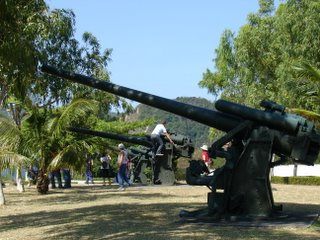




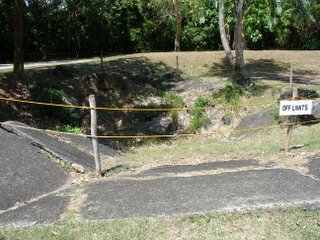
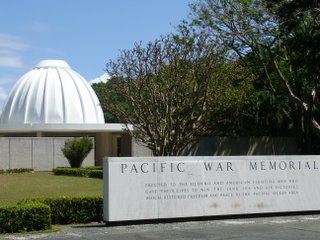
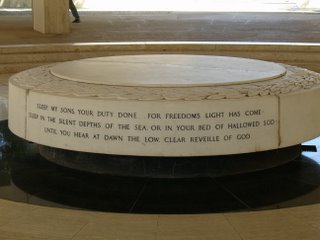

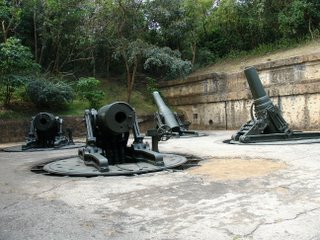




On the ferry over to Corregidor we had a Filipino war veteran give a talk, he said that the Spanish gave the Phillipines "Infrastructure, Education and Religion"...America gave "Coca-Cola". After having spent time at Corregidor I can't help feeling that America also gave the Philippines something that is more far, far more precious - "Freedom".
Sources and further reading..
Corregidor Historic Society
Back to Bataan - a survivor's story
Corregidor
I would like to point out that Corregidor is one of a group of islands that were used to defend Manila Bay. I'll write about the others in another post.

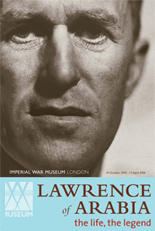











3 Comments:
thanks. most interseting
I am ashamed that I have been living here since birth and I haven't been to Corregidor. I am booking a trip before end of March.
So, I do not really think this will work.
ottawa
Post a Comment
<< Home